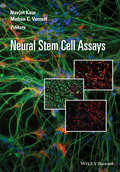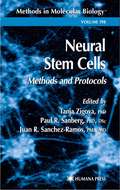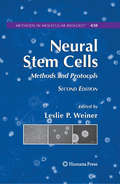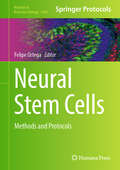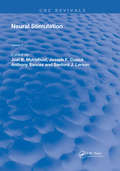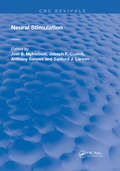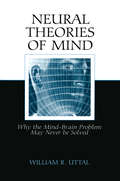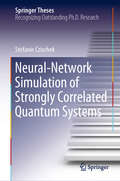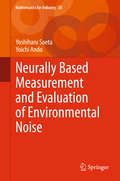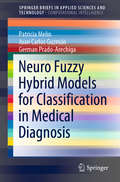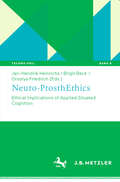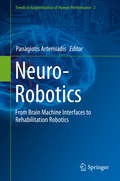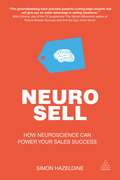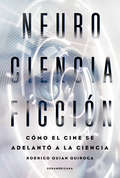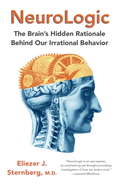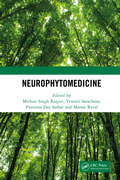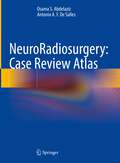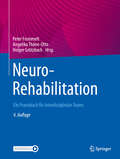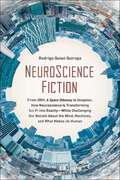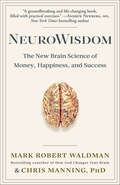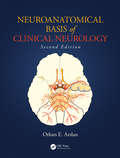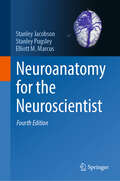- Table View
- List View
Neural Stem Cell Assays
by N. Kaur Mohan VemuriNeural stem cells offer a valuable model system for delineating the cellular and developmental processes in normal and diseased states of the central nervous system. In particular, neural stem cells have huge potential in regenerative medicine, owing to their expansion capability in culture and the ability to differentiate into multiple sub-neural lineages. Neural Stem Cell Assays provides a detailed and comprehensive review of the basic methods for neural stem cell cultures. Including an overview of progress in the field over the past decade, Neural Stem Cell Assays is a one-stop reference for consistent methods and reliable tools that span the entire assay work flow, from isolation or generation of neural stem cells to characterization, manipulation and final application of neural stem cells in disease paradigms such as Parkinson's disease, multiple sclerosis and amyotrophic lateral sclerosis. An excellent source of information for academic, pharmaceutical and biotechnology researchers who are new to the neural stem cell field, Neural Stem Cell Assays is an invaluable to experienced users who wish to integrate newly developed tools and technologies into their workflow. The book also covers important course material for students at the undergraduate and graduate level who are learning the basics of neural stem cell cultures, and differentiation to sub-neural lineages.
Neural Stem Cells
by Tanja Zigova Juan R. Sanchez-Ramos Paul R. SanbergIn Neural Stem Cells: Methods and Protocols, internationally recognized experts from academic, clinical, and pharmaceutical laboratories describe in great detail the most frequently used cellular, molecular, and electrophysiological methods to isolate, characterize, and utilize neural stem cells. These readily reproducible techniques introduce the various sources of stem/progenitor cells, provide a wide range of conditions for their culture, and make it possible to define their properties in culture. Additional techniques are designed to help researchers identify endogenous stem cells as well as exogenous stem cells after transplantation in the brain. The protocols range from the simplest methods of isolation and characterization of neural cell properties to such very sophisticated methods as characterizing gene expression, telomerase assays, and cell cycle kinetics.
Neural Stem Cells
by Leslie P. WeinerMany questions related to stem cell properties and neural stem cell lineage and differentiation still linger. This second edition revises and expands upon the successful first edition in order to provide the most current, cutting-edge methods of today for the scientists working to answer these questions. The use of these step-by-step, readily reproducible laboratory protocols will allow investigators to produce pure populations that can serve as a means of understanding the biology of neural stem cells and adapting them for transplantation into disease models. This is an excellent source of information and inspiration.
Neural Stem Cells: Methods and Protocols (Methods in Molecular Biology #2899)
by Felipe OrtegaThis detailed volume explores techniques for the study of neurogenic niches and neural lineage progression, specifically addressing major methodological challenges in studying neural stem cells (NSCs) and related cell populations, such as astrocytes, oligodendrocytes, and neurons. The chapters are organized to offer a comprehensive technical foundation, focusing on isolation and identification, monitoring, manipulation, analysis, and the exploration of potential therapeutic applications of NSCs. Written for the highly successful Methods in Molecular Biology series, chapters include introductions to their respective topics, lists of the necessary materials and reagents, step-by-step and readily reproducible laboratory protocols, and tips on troubleshooting and avoiding known pitfalls. Authoritative and practical, Neural Stem Cells: Methods and Protocols serves as an ideal guide for the scientific community and a broader audience interested in understanding neurogenic niches and the progression of neural lineages.
Neural Stimulation (Routledge Revivals)
by Joel B. Myklebust Anthony Sances Joseph F. Cusick Sanford J. LarsonFirst Published in 1985, this book offers a full, comprehensive investigation into Stimulation of the brain. Carefully compiled and filled with a vast repertoire of notes, diagrams, and references this book serves as a useful reference for Neurobiologists, and other practitioners in their respective fields.
Neural Stimulation (Routledge Revivals)
by Joel B. Myklebust Anthony Sances Joseph F. Cusick Sanford J. LarsonFirst Published in 1985, this book offers a full, comprehensive investigation into Stimulation of the brain. Carefully compiled and filled with a vast repertoire of notes, diagrams, and references this book serves as a useful reference for Neurobiologists, and other practitioners in their respective fields.
Neural Theories of Mind: Why the Mind-Brain Problem May Never Be Solved
by William R. UttalIn this fascinating book, William R. Uttal raises the possibility that, however much we learn about the anatomy and physiology of the brain and psychology, we may never be able to cross the final bridge explaining how the mind is produced by the brain. Three main classes of mind-brain theory are considered and rejected: field theories, because they are based on a superficial analogy; single cell theories, because they emerge from a massive uncontrolled experimental program; and neural net theories, because they are constrained by combinatorial complexity.To support his argument, Uttal explores the empirical and conceptual foundations of these theoretical approaches and identifies flaws in their fundamental logic. The author concludes that the problems preventing solution of the mind-brain problem are intractable, yet well within the confines of natural science.
Neural-Network Simulation of Strongly Correlated Quantum Systems (Springer Theses)
by Stefanie CzischekQuantum systems with many degrees of freedom are inherently difficult to describe and simulate quantitatively. The space of possible states is, in general, exponentially large in the number of degrees of freedom such as the number of particles it contains. Standard digital high-performance computing is generally too weak to capture all the necessary details, such that alternative quantum simulation devices have been proposed as a solution. Artificial neural networks, with their high non-local connectivity between the neuron degrees of freedom, may soon gain importance in simulating static and dynamical behavior of quantum systems. Particularly promising candidates are neuromorphic realizations based on analog electronic circuits which are being developed to capture, e.g., the functioning of biologically relevant networks. In turn, such neuromorphic systems may be used to measure and control real quantum many-body systems online. This thesis lays an important foundation for the realization of quantum simulations by means of neuromorphic hardware, for using quantum physics as an input to classical neural nets and, in turn, for using network results to be fed back to quantum systems. The necessary foundations on both sides, quantum physics and artificial neural networks, are described, providing a valuable reference for researchers from these different communities who need to understand the foundations of both.
Neurally Based Measurement and Evaluation of Environmental Noise
by Yoichi Ando Yoshiharu SoetaThis book deals with methods of measurement and evaluation of environmental noise based on an auditory neural and brain-oriented model. The model consists of the autocorrelation function (ACF) and the interaural cross-correlation function (IACF) mechanisms for signals arriving at the two ear entrances. Even when the sound pressure level of a noise is only about 35 dBA, people may feel annoyed due to the aspects of sound quality. These aspects can be formulated by the factors extracted from the ACF and IACF. Several examples of measuring environmental noise--from outdoor noise such as that of aircraft, traffic, and trains, and indoor noise such as caused by floor impact, toilets, and air-conditioning--are demonstrated. According to the noise measurement and evaluation, applications for sound design are discussed. This book provides an excellent resource for students, researchers, and practitioners in a wide range of fields, such as the automotive, railway, and electronics industries, and soundscape, architecture, and acoustics.
Neuro Fuzzy Hybrid Models for Classification in Medical Diagnosis (SpringerBriefs in Applied Sciences and Technology)
by Patricia Melin German Prado-Arechiga Juan Carlos GuzmánThis book is focused on the use of intelligent techniques, such as fuzzy logic, neural networks and bio-inspired algorithms, and their application in medical diagnosis. The main idea is that the proposed method may be able to adapt to medical diagnosis problems in different possible areas of the medicine and help to have an improvement in diagnosis accuracy considering a clinical monitoring of 24 hours or more of the patient.In this book, tests were made with different architectures proposed in the different modules of the proposed model. First, it was possible to obtain the architecture of the fuzzy classifiers for the level of blood pressure and for the pressure load, and these were optimized with the different bio-inspired algorithms (Genetic Algorithm and Chicken Swarm Optimization). Secondly, we tested with a local database of 300 patients and good results were obtained. It is worth mentioning that this book is an important part of the proposed general model; for this reason, we consider that these modules have a good performance in a particular way, but it is advisable to perform more tests once the general model is completed.
Neuro-Narrative Therapy: New Possibilities For Emotion-filled Conversations
by Jeffrey ZimmermanBringing interpersonal neurobiology and narrative therapy together. Narrative therapy understands storytelling as the way we make sense of ourselves and life experience. Many non-narrative therapists have expressed great admiration and interests in the politics the work exposes, the way it brings in the socio-political context, and the way it centers clients. Yet despite its popularity and success as a useful therapeutic approach, Narrative Therapy has been criticized as minimizing and failing to develop any extended discussion of something vital to our lives: emotion. Neuro-Narrative Therapy attempts to redress this problem by taking us first through standard Narrative practices, and then showing how and where affect can be brought in and even privileged in the work. After situating the evolution of Narrative Therapy in its historical context, the book provides information about why emotions should be given an important place in the work. Specifically, it brings ideas and implications of some of the most exciting and novel theories—interpersonal neurobiology and affective neuroscience—to the practice of Narrative Therapy. Readers will learn about the growing emphasis on the right brain, and how an understanding of the ways in which emotion and affect are manifested by the brain can help us help our clients. The possibilities for this new approach are many: a freer discussion of the emotional side of your clients; an understanding and sensitivity to the relation of body and mind; attention to how the therapeutic relationship of our clients can become a resource in treatment and a renewed understanding of how our memories—and thus our stories about our lives—develop in early childhood and beyond. For any therapist working in the area of Narrative Therapy, and for any interested in the emerging understandings that science is bringing to appreciating how our brains develop with and among each other, this book has something to offer. Combining the neuro- and the narrative, as Jeffrey Zimmerman has done here, will create a new direction in Narrative Therapy, one in which our brain and body work together, inviting a more direct and effective engagement with clients.
Neuro-ProsthEthics: Ethical Implications of Applied Situated Cognition (Techno:Phil – Aktuelle Herausforderungen der Technikphilosophie #9)
by Jan-Hendrik Heinrichs Birgit Beck Orsolya FriedrichThe volume focusses on the ethical dimensions of the technological scaffold embedding human thought and action, which has been brought to attention of the cognitive sciences by situated cognition theories. There is a broad spectrum of technologies co-realising or enabling and enhancing human cognition and action, which vary in the degree of bodily integration, interactivity, adaptation processes, of reliance and indispensability etc. This technological scaffold of human cognition and action evolves rapidly. Some changes are continuous, some are eruptive. Technologies that use machine learning e.g. could represent a qualitative leap in the technological scaffolding of human cognition and actions. The ethical consequences of applying situated cognition theories to practical cases had yet to find adequate attention and are elucidated in this volume.
Neuro-Robotics
by Panagiotis ArtemiadisNeuro-robotics is one of the most multidisciplinary fields of the last decades, fusing information and knowledge from neuroscience, engineering and computer science. This book focuses on the results from the strategic alliance between Neuroscience and Robotics that help the scientific community to better understand the brain as well as design robotic devices and algorithms for interfacing humans and robots. The first part of the book introduces the idea of neuro-robotics, by presenting state-of-the-art bio-inspired devices. The second part of the book focuses on human-machine interfaces for performance augmentation, which can seen as augmentation of abilities of healthy subjects or assistance in case of the mobility impaired. The third part of the book focuses on the inverse problem, i. e. how we can use robotic devices that physically interact with the human body, in order (a) to understand human motor control and (b) to provide therapy to neurologically impaired people or people with disabilities.
Neuro-Sell
by Simon HazeldineAnyone involved in sales faces huge challenges these days, from fierce global competition, pressure on margins, difficulties of getting time with prospective buyers and the power of internet-savvy buyers. To succeed in sales, you need something more than the traditional techniques. Neuro-Sell gives you the edge through a brain-based perspective, process and approach to selling that is sensitive to what's going on in your customers' minds. Learn how to really relate to your prospects and sell in a way that is comfortable for both buyer and seller. Understand the importance of the unconscious and find out how to get below the surface level of what people say to recognise what they really mean. Develop your skills in building sales relationships with the four main types of buyer by fully understanding their needs. And discover the five stages of neuro-negotiating that will see your sales rates rocket.
Neuro: The New Brain Sciences and the Management of the Mind
by Nikolas Rose Joelle M. Abi-RachedHow the new brain sciences are transforming our understanding of what it means to be humanThe brain sciences are influencing our understanding of human behavior as never before, from neuropsychiatry and neuroeconomics to neurotheology and neuroaesthetics. Many now believe that the brain is what makes us human, and it seems that neuroscientists are poised to become the new experts in the management of human conduct. Neuro describes the key developments—theoretical, technological, economic, and biopolitical—that have enabled the neurosciences to gain such traction outside the laboratory. It explores the ways neurobiological conceptions of personhood are influencing everything from child rearing to criminal justice, and are transforming the ways we "know ourselves" as human beings. In this emerging neuro-ontology, we are not "determined" by our neurobiology: on the contrary, it appears that we can and should seek to improve ourselves by understanding and acting on our brains.Neuro examines the implications of this emerging trend, weighing the promises against the perils, and evaluating some widely held concerns about a neurobiological "colonization" of the social and human sciences. Despite identifying many exaggerated claims and premature promises, Neuro argues that the openness provided by the new styles of thought taking shape in neuroscience, with its contemporary conceptions of the neuromolecular, plastic, and social brain, could make possible a new and productive engagement between the social and brain sciences.Copyright note: Reproduction, including downloading of Joan Miro works is prohibited by copyright laws and international conventions without the express written permission of Artists Rights Society (ARS), New York.
NeuroCienciaFicción: Cómo el cine se adelantó a la ciencia
by Rodrigo Quian QuirogaEl neurocientífico Rodrigo Quian Quiroga cuenta cómo la neurociencia está llegando adonde solo creíamos que podía llegar la ciencia ficción: borrar o implantar recuerdos, implantar prótesis neuronales o la posibilidad de leer la mente ya no pertenecen a la imaginación de un guionista, se han vuelto realidad. El cine imagina más allá de lo posible, suele anticiparse a su época y propone avances fascinantes y disruptivos. En Inception, un grupo de conspiradores implanta falsos recuerdos; en Hasta el fin del mundo, un científico alocado llega a leer los sueños; en 2001: Odisea del espacio, una supercomputadora siente y piensa como una persona. Pero así como el cine de ciencia ficción se apoya en los últimos avances de la ciencia, la ciencia también se nutre de la prolífica imaginación de los cineastas y de pronto vemos que es una realidad aquello que alguna vez fue fantasía: implantar memorias manipulando a voluntad grupos de neuronas a través de la optogenética , leer la mente durante el sueño a partir de avanzados algoritmos de decodificación, o lograr que las computadoras superen el pensamiento humano en infinidad de tareas mediante redes neuronales profundas; logros científicos concretos de los últimos años. El físico y neurocientífico Rodrigo Quian Quiroga, director del Centro de Neurociencia de Sistemas en la Universidad de Leicester en Inglaterra, propone un cruce entre el arte, la ciencia y la filosofía y se pregunta hasta dónde ha llegado el cine con sus fabulosas especulaciones y cuántas de éstas se están materializando en los laboratorios del mundo. Para eso, analiza cómo la ciencia está logrando lo que hace décadas parecía imposible, y cómo estos avances nos llevan a replantearnos las grandes preguntas filosóficas que el hombre viene haciéndose desde siempre.
NeuroLogic
by Eliezer SternbergA groundbreaking investigation of the brain's hidden logic behind our strangest behaviors, and of how conscious and unconscious systems interact in order to create our experience and preserve our sense of self. From bizarre dreams and hallucinations to schizophrenia and multiple personalities, the human brain is responsible for a diverse spectrum of strange thoughts and behaviors. When observed from the outside, these phenomena are often written off as being just "crazy," but what if they were actually planned and logical? NeuroLogic explores the brain's internal system of reasoning, from its unconscious depths to conscious decision making, and illuminates how it explains our most outlandish as well as our most stereotyped behaviors. From sleepwalking murderers, contagious yawning, and the brains of sports fans to false memories, subliminal messages, and the secret of ticklishness, Dr. Eliezer Sternberg shows that there are patterns to the way the brain interprets the world---patterns that fit the brain's unique logic. Unraveling these patterns and the various ways they can be disturbed will not only alter our view of mental illness and supernatural experience, but will also shed light on the hidden parts of ourselves. (With black-and-white illustrations throughout.)From the Hardcover edition.
NeuroLogic: The Brain's Hidden Rationale Behind Our Irrational Behavior
by Eliezer SternbergA groundbreaking investigation of the brain's hidden logic behind our strangest behaviors, and of how conscious and unconscious systems interact in order to create our experience and preserve our sense of self. From bizarre dreams and hallucinations to schizophrenia and multiple personalities, the human brain is responsible for a diverse spectrum of strange thoughts and behaviors. When observed from the outside, these phenomena are often written off as being just "crazy," but what if they were actually planned and logical? NeuroLogic explores the brain's internal system of reasoning, from its unconscious depths to conscious decision making, and illuminates how it explains our most outlandish as well as our most stereotyped behaviors. From sleepwalking murderers, contagious yawning, and the brains of sports fans to false memories, subliminal messages, and the secret of ticklishness, Dr. Eliezer Sternberg shows that there are patterns to the way the brain interprets the world---patterns that fit the brain's unique logic. Unraveling these patterns and the various ways they can be disturbed will not only alter our view of mental illness and supernatural experience, but will also shed light on the hidden parts of ourselves. (With black-and-white illustrations throughout.)From the Hardcover edition.
NeuroPhytomedicine
by Mithun Singh Rajput Tewarit Sarachana Purnima Dey Sarkar Manan RavalNeurological disorders categorized as neurodegenerative, neuropsychiatric, and neurotraumatic impose a substantial health burden and cause a frail impact on life attributes. The use of synthetic drugs can have undesirable side effects, making neurotherapeutics challenging. Research on neuroprotection aiming for the utilization of safer natural compounds; phytochemicals specifically – is a cutting-edge approach. NeuroPhytomedicine intends to present readers with a wide-ranging and state-of-the-art appearance at the beneficial properties of phytochemicals on various neurological ailments. It additionally contains sections explaining: • Applications of phyto-nanotechnology in neurological ailments, • Phytoconstituents related deep learning and machine learning-based solutions for neurological disorders, • Epigenetic relevance pertaining to modulation by phytochemicals. The goal of NeuroPhytomedicine is to give readers a thorough and up-to-date look at how phytochemicals affect the brain and neurological illnesses in a way that is helpful for research scholars, academicians, scientists, neuroscientists, physicians, and researchers from the pharmaceutical industry.
NeuroRadiosurgery: Case Review Atlas
by Osama S. Abdelaziz Antonio A.F. De SallesThis book is one-of-a-kind comprehensive Radiosurgery Case Review Atlas that includes not only cranial and spinal cases, but also structural and functional radiosurgery ones. It categorizes the various radiosurgery-treated pathologies, presenting illustrative case reviews for each category. Each case includes a clinical summary, a treatment protocol, a radiosurgery dosimetry summary, the pre-radiosurgery images and the serial, short-term and long-term, follow up images illustrating the clinical and radiologic outcomes of the radiosurgery treatment. Offering the readers a handy step-by-step practical guide to perform safe and effective radiosurgery treatment, this will be a useful toolkit for neurosurgeons, radiation neuro-oncologists and radiation physicists (Radiosurgeons) conducting radiosurgery programs or involved in radiosurgery training.
NeuroRehabilitation: Ein Praxisbuch für interdisziplinäre Teams
by Holger Grötzbach Peter Frommelt Angelika Thöne-OttoDas Praxisbuch der Neurorehabilitation…… komplett aktualisiert und überarbeitet: Das große Praxisbuch bietet Grundlagen- und Praxiswissen, detailliert, kritisch, verständlich und an den Bedürfnissen der Patienten orientiert – ein rundum alltagstaugliches Arbeitsbuch für Teams, ein Lehrbuch für die Aus- und Weiterbildung. Mit neuen Kapiteln u.a. zu Telerehabilitation und der Umsetzung spezieller Therapieformen wie Virtual Reality, musikgestützte Therapie, Natur und Tiere.Umfassend: Mit ausführlicher Darstellung der Grundlagen und der Tätigkeitsfelder, beginnend von der Behandlung auf der Stroke Unit bis hin zur Rückkehr in Familie und Beruf.Interdisziplinär: Die gemeinsame Ausbildungs – und Arbeitsgrundlage für alle Berufsgruppen, die in interdisziplinären Teams zusammenarbeiten: Ärzte, Pflegekräfte, Physiotherapeuten, Ergotherapeuten, Logopäden, Neuropsychologen, Sozialpädagogen, Musiktherapeuten u.a.Aktuell: Wissenschaftlich, evidenzbasiert, durchgängig mit bio-psycho-sozialer Orientierung und von den Prinzipien der ICF (Internationale Klassifikation der Funktionsfähigkeit, Behinderung und Gesundheit) geleitet.Kompetent: Fundiertes Fachwissen aus langjähriger Erfahrung, vermittelt von über 50 renommierten internationalen Autoren (aus Deutschland, Schweiz, Großbritannien, Finnland, USA).Informativ: Auch mit Reflexionen über Themen wie „Kontextsensitive Neurorehabilitation“ „Teamarbeit und Zielsetzung“, „Sexualität“, „ Identität und Biografie“, „Holistische neuropsychologische Rehabilitation“.Leserfreundlich: Leicht zugänglich mitEinheitlicher Aufbau der Kapiteloptischer Textstrukturierung: mit Trailers, Praxistipps, Übersichtsboxen, Exkursen („Näher betrachtet“) und mehr…
NeuroScience Fiction: How Neuroscience Is Transforming Sci-Fi into Reality-While Challenging Our Belie fs About the Mind, Machines, and What Makes us Human
by Rodrigo Quian QuirogaWhat if science fiction stopped being fiction? Developments in neuroscience are turning sci-fi scenarios into reality, and causing us to revisit some of the philosophical questions we have been asking ourselves for centuries. Science fiction often takes its inspiration from the latest science . . . and our oldest questions. After all, the two are inextricably linked. At a time when advances in artificial intelligence are genuinely leading us closer to a computer that thinks like a human, we can't help but wonder: What makes a person a person? Countless writers and filmmakers have created futuristic scenarios to explore this issue and others like it. But these scenarios may not be so futuristic after all. In the movie Inception, a group of conspirators implants false memories; in Until the End of the World, a mad scientist is able to read dreams; in 2001: A Space Odyssey, a supercomputer feels and thinks like a person. And in recent years, the achievements described in leading scientific journals have included some that might sound familiar: implanting memories using optogenetics, reading the mind during sleep thanks to advanced decoding algorithms, and creating a computer that uses deep neural networks to surpass the abilities of human thought. In NeuroScience Fiction, neuroscientist and author Rodrigo Quiroga reveals the futuristic present we are living in, showing how the far-out premises of 10 seminal science fiction movies are being made possible by discoveries happening right now, on the cutting edge of neuroscience. He also explores the thorny philosophical problems raised as a result, diving into Minority Report and free will, The Matrix and the illusion of reality, Blade Runner and android emotion, and more. A heady mix of science fiction, neuroscience, and philosophy, NeuroScience Fiction takes us from Vanilla Sky to neural research labs, and from Planet of the Apes to what makes us human. This is a book you'll be thinking about long after the last page—and once you've read it, you'll never watch a sci-fi blockbuster the same way again.
NeuroWisdom: The New Brain Science of Money, Happiness, and Success
by Mark Robert Waldman Chris Manning“Remarkable . . . If you want to double your happiness and your income, start using these powerful brain-changing exercises today!” ―John Assaraf, New York Times-bestselling author and CEO of NeuroGymAdapted from a business school course they created for professionals, bestselling author Mark Waldman and Chris Manning present simple brain exercises, based on the latest neuroscience research, to guide readers to improvement in all parts of life, from work to home, from how we think to how we feel.Their promise is to help people create more “wealth” in their lives, defined as the combination of money, happiness, and success. Using the latest research studied by two experts in their field, the book presents both the scientific background and sets of “NeuroWisdom” exercises that will help people reduce neurological stress and increase happiness, motivation, and productivity. The “worry” centers of the brain are turned off and the optimism circuits are turned on. Work becomes more pleasurable and creativity is increased, enabling the brain to anticipate and solve problems more efficiently.From the cutting edge of brain science to real-world solutions, these exercises help readers gain the wisdom that leads to greater fulfillment.“Whether you are rich or poor, happy or sad, contented or lost—you can use the practical strategies in this book to deepen your sense of well-being. The new brain science described in this book will challenge some of your deepest beliefs about money and happiness, and the mindfulness exercises will help you unlock the hidden creativity that lies dormant in your brain.” —Daniel Amen, MD, #1 New York Times-bestselling author“A groundbreaking and life-changing book, filled with practical exercises.” ―Andrew Newberg, MD, New York Times-bestselling author
Neuroanatomical Basis of Clinical Neurology
by Orhan E. ArslanBridging the gap between the peripheral and central nervous systems, the second edition of Neuroanatomical Basis of Clinical Neurology enriches understanding of neurological conditions through a conceptual approach to neuronal circuitry. The book retains the basic outline of contents from the first edition, integrating structural organization with
Neuroanatomy for the Neuroscientist
by Stanley Jacobson Elliott M. Marcus Stanley PugsleyIt is truer in neurology than in any other system of medicine that a firm knowledge of basic science material, that is, the anatomy, physiology, and pathology of the nervous system, enables one to readily arrive at the diagnosis of where the disease process is located and to apply their knowledge at solving problems in clinical situations. The purpose of this textbook is to enable a neuroscientist to discuss the structure and functions of the brain at a level appropriate for students at many levels of study including undergraduate, graduate, dental, or medical school level. The authors have a long experience in teaching neuroscience courses at the first- or second-year level to medical and dental students and to residents in which clinical information and clinical problem-solving are integral to the course. The authors reach this object by integrating basic sciences with neurological clinical cases containing MRI, CT or fMRI images.
